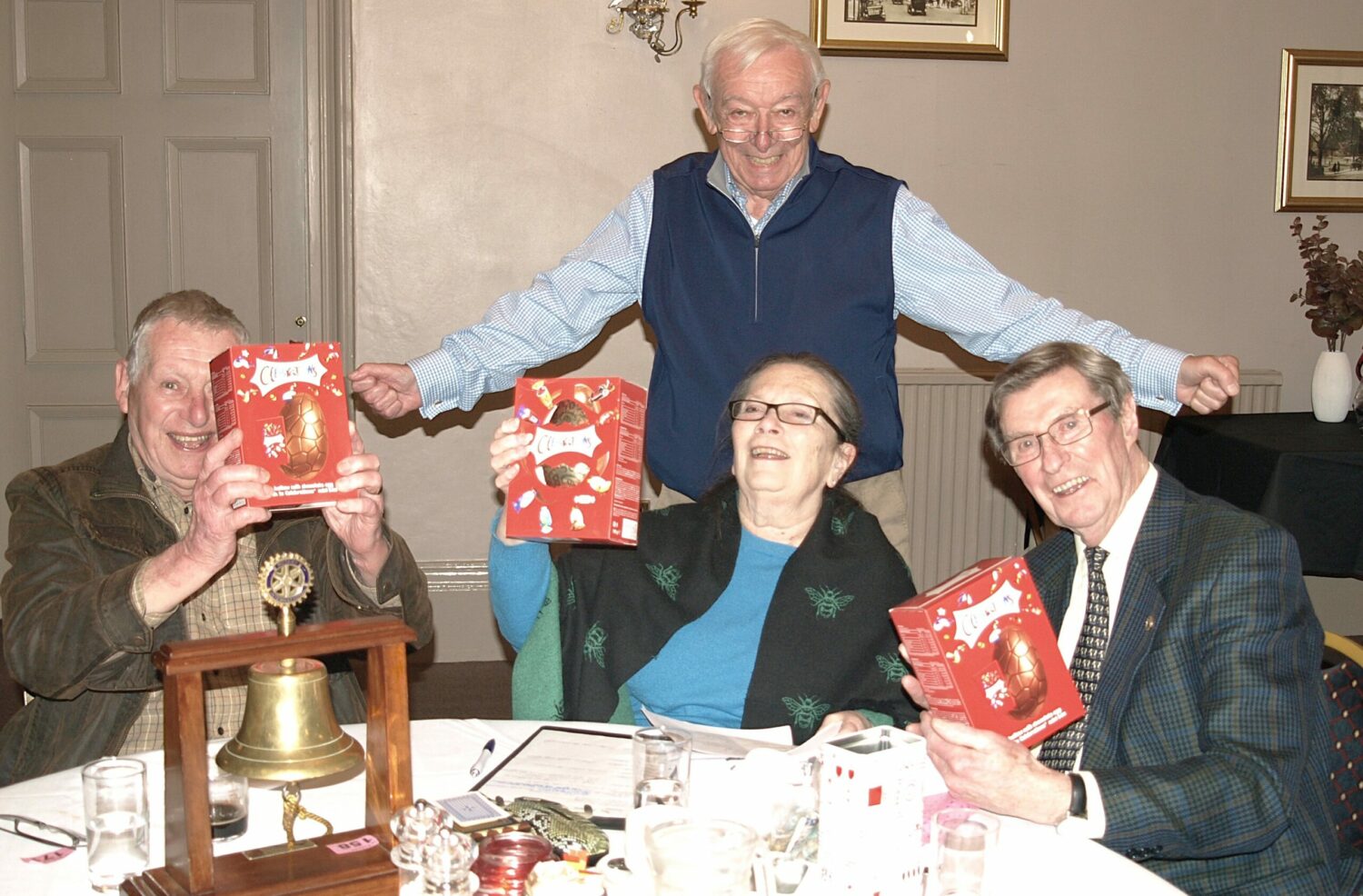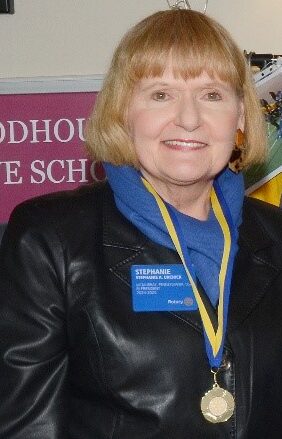November 11, 2023
On Remembrance Sunday at one o’clock Harrogate Brigantes held their 26th annual Remembrance Service at the Commonwealth War Graves cemetery at Stonefall. There are over 1000 graves, most of them of young airmen, mostly volunteeers, who came from around the world to help us fight off Nazi Germany during the Second World War. Thye deserve to be remembered. We have a lot to thank them for.
This year the short service told the tragic story of one Lancaster crew, 6 Canadians and one Englishman, a young Jew from Hackney. Their plane, DS 837, crashed into the Howardian Hills at Yearsley on its return from a bombing raid on Berlin on 16 December 1943. The tail of the plane broke off on impact and the rear gunner survived but the rest were killed.
They were not the only ones to die that night. It has gone down in history as “the RAF’s Black Thursday.” The cloud was very low, so returning crews were using the Standard Beam Approach in which they followed signals sent from beacons in line with the main runway of their airfield. They were relying on their altimeters to tell them where the ground was. But the altimeters then in use were sensitive to barometric pressure. The pressure had changed considerably since take-off and the returning crews had been given new settings, incorrect new settings, so their altimeters were not working properly.
And so, as the crew DS 837 passed over the Howardian Hills, they were lower than they thought. Just outside the village of Yearlsey a wing clipped a haystack and the plane veered straight across the main street, taking off the roofs of farm buildings before crashing into a tree in the field beyond.
The villagers did what they could. One member of the crew was dragged alive from the wreckage and carried to the local pub where he sadly died. And the village still remembers. There is a plaque in the church and villagers have collected together papers and material to form a lasting record of the tragedy. They will not forget, nor should we.
In Stonefall cemetery the crew lies together. On the headstone of the one Englishman to die at Yearsley is a simple reminder of the pain of loss. “Gone but not forgotten by his mum and dad, brother Sam and fiancée Edna.” That, surely, is the true pity of war, and why we should never forget.


The full story
A little before midnight on the evening of 16th December 1943, just under 80 years ago a Lancaster bomber returning to its base at Linton-on-Ouse crashed into the Howardian Hills at the village of Yearsley (that’s beyond Knaresborough, over there) about 11 flying miles from home. Six of the seven crew were killed. The rear gunner survived. The six who died are still together. Just over there where you see the flags. I’d like to tell you their story. It’s a story of the pity of war as Wilfrid Owen put it.
As was common for bomber crews they were not all from one country. Five of those who died were Canadians: the pilot, Squadron Leader Thomas Matthew Kneale, aged 29, from Woodstock, Ontario; the navigator George Macdonald Jones, aged 23, from Waterloo Ontario; the bomb aimer James McKay, aged 23, from Dodsland, Saskatchewan; the wireless operator and air gunner Maurice Milton Prill, aged 22, from Minburn, Alberta; and the mid upper gunner Angus Augustus Johnston about whom nothing is known. And one was English – the Flight engineer Robert Philip Marks aged 22 from Hackney. The pity of war. The one who survived, Gordon Fortier, was the rear gunner. He lived, it is believed, because the rear turret broke away from the rest of the aircraft as it crashed.
They were an experienced crew. For most of them it was their 16th operational flight together. The target was Berlin which came under concentrated attack from November 1943 to January 1944. On the night of 16th December 483 Lancaster bombers and 15 Mosquitos flew towards the German capital. And German night fighters were waiting for them. 25 Lancasters were shot down killing 175 crew. The pity of war. The pathfinder Mosquitos, though, managed to mark the city accurately. As a result, the National Theatre and the National Archives buildings were destroyed along with many houses and considerable damage was done to the railway network. By this time a quarter of Berlin’s accommodation had been made unusable and the cumulative strain on the railways was delaying supplies to Russian front. Bombing was having an effect. On the ground that night the bombing killed about 720 people. The pity of war.
To avoid the night fighters the bombers took a less direct route home over Denmark. But aircraft returning to bases in Cambridgeshire, Lincolnshire and North Yorkshire encountered very low cloud when coming into land. 29 Lancasters crashed killing about 150 men including the crew of Lancaster DS 837 that Yearsley. The day was soon christened “the RAF’s Black Thursday” as a result. The pity of war. In the low cloud the aircraft had to use the Standard Beam Approach in which they followed signals sent from beacons in line with the main runway of their airfield. It was tricky at the best of times. But when the crew of DS 837 radioed to Linton that they were getting near they were told that the transmitting equipment was not working and they were told to divert to East Moor airfield at Sutton-on-the-Forest, where the beacons were operating. They crashed just six flying miles from the safety of that base. The probable cause was that the altimeter used at the time was sensitive to barometric pressure. The pressure had changed considerably since take-off and they and other crews were given incorrect new settings which meant that their altimeters were not working properly. And so, as they passed over the Howardian Hills, they were lower than they thought. Just outside the village a wing clipped a haystack and the plane veered straight across the main street, taking off the roofs of farm buildings before crashing into a tree in the field beyond. Five of the crew died instantly, one was rescued by villagers and carried to the Wombwell Arms where he died. And one survived. The pity of war.
It was King George V who in 1919 decided that at remembrance events the silence should be two minutes long – one minute for those who died and one minute for those who survived, so remembering and honouring all who served in whatever capacity. There were many like the crew of Lancaster DS 837, who have given or been prepared to give their lives in the service of others. We remember them all, we give thanks to them all. And let us remember, too, those who were left to grieve. On the headstone of the one Englishman to die at Yearsley on that Black Thursday 80 years ago is a simple reminder of the pain of loss. “Gone but not forgotten by his mum and dad, brother Sam and fiancée Edna.” That, surely, is the true pity of war.
Share this article:
Latest News
-

Kids Aloud 2025
Put a several hundred kids from six local primary schools onto the stage of Harrogate’s magnificent Royal Hall, give them...
-

Brigantes Members Challenged by ” A Very Easy Quiz”
Well, that was what quizmaster, Dastardly Doveston, billed it as. But the member attending on 8 April found out the...
-

North Yorkshire Rotary Technology Tournament 2025
The 2025 Rotary Technology Tournament, organised by Bob Tunnicliffe from Harrogate Brigantes, attracted 34 teams from local secondary schools. Students...
-

Rotary G B I Showcase Event, Nell Bank, Ilkley
Nell Bank Centre near Ilkley was the setting for a Showcase Event on 5th March attended by Stephanie Urchick, the...

